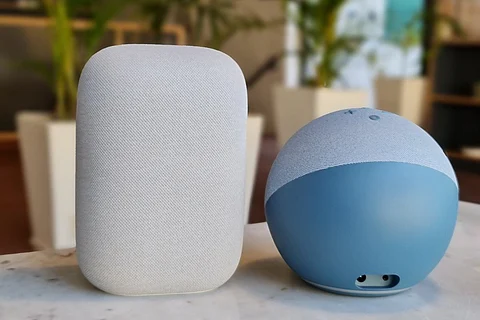

Smart speakers are hardly adding any new features these days. It’s become a struggle for the makers as there is only so much they can do. Two new products that have come out in the past month or so try and sway consumers towards the ‘smarter’ life despite the limitations. There’s Google’s Nest Audio and the fourth generation Amazon Echo.
Both the Google Nest Audio and Amazon Echo are loud and bold speakers. The Echo is spherical in shape and weighs just under a kilogram. It’s got a fabric exterior for the most part.
The Google Nest Audio is also predominately covered in fabric. The oval-shaped speaker is just under 7 inches tall. In a side-by-side comparison, the Nest Audio towers over the Amazon Echo. At 1.2 kgs, the Nest Audio is also heftier.
Both smart speakers have a mic toggle and LED lights. The Echo’s lights are located near the base in a ring-formation while the Nest Audio’s are four horizontal dots on the front side of the speaker.
One major difference between the two is the fact that the Amazon Echo has a 3.5mm audio line out/in port and that you can use it wirelessly as a speaker for your smart TV. That doesn’t apply to the Nest Audio.
The Amazon Echo also has controls on the top (there are physical buttons for volume and to mute/trigger Alexa), unlike the Nest Audio which is buttonless. For the Nest Audio, you just tap on the corners to adjust the volume and tap the middle to play or pause the audio.
Sound quality is the second most important feature in a smart speaker, after voice recognition. To the untrained ear and the average consumers, the two will sound the same. They are very similar.
Both companies have managed to drastically improve the sound quality. Google has vastly improved the Nest Audio’s sounds by upgrading the internal parts. You now get a less muffled sound.
The Amazon Echo has two 0.8-inch tweeters and a 3-inch woofer. This gives it better range. The Amazon Echo has a deeper, fuller sound that packs more of a punch than the Nest Audio. It throws the sound further in the room than the Nest Audio. That isn’t to say that the Nest Audio isn’t capable as a speaker for listening to music.
Google says the Nest Audio is "75% louder with a 50% stronger bass than the original” and that’s because of the new 19mm tweeter and 75mm mid-woofer.
Where the Nest Audio excels is in clarity voices in songs. That and acoustic tracks sounds better. The Amazon Echo has better bass in a lot of the songs.
In the end, they are both nearly identical in sound quality and it will come down to personal preference. Both are vast improvements from their previous generations.
Last but not least, both the speakers support stereo sound. That means that if you buy more than one of them, they can play in tandem.
Google’s got an entire search engine worth of information to back up its Assistant. Amazon, on the other hand, has a new chip inside the 4th generation Amazon Echo that makes processing voice recognition much faster.
Alexa is good for comprehending day-to-day tasks but if you have numerous questions that need answers, then the Google Assistant is the better bet.
Nest Audio features a toggle while Amazon Echo has a button at the top for turning the mic on/off.
Both the Nest Audio and 4th generation Amazon Echo are tremendous upgrades over their predecessors. If you’re in the market for a smart speaker, then there is no better time than right now.
The Nest Audio currently retails for Rs 7,999 on Flipkart while the Amazon Echo is available on Amazon for Rs 8,999. Being similarly priced and a match in sound quality, the difference here lies in the smartness of each speaker. Are you in love with the Google Assistant on your mobile phone or do you want to hear a different voice - aka Alexa - for answers to your questions?
For most people, it comes down to personal preference. For me, it is the vast library of the Google search engine over Amazon Echo’s slightly superior sound quality.
Buy one or buy both. You won’t be disappointed either way. The smart speaker ecosystem is at its best right now and with the library of available commands improving by the day, things will only get better.